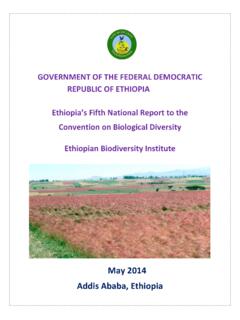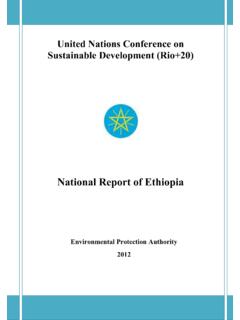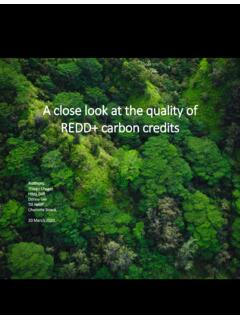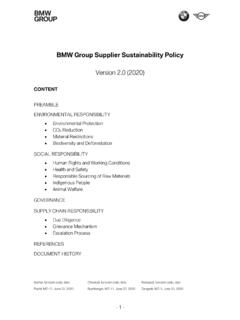Transcription of 2 CARBON MARKETS – WHICH TYPES EXIST AND HOW THEY …
1 5 Two TYPES of CARBON market EXIST ; the regulatory compliance and the voluntary MARKETS . The compliance market is used by companies and governments that by law have to account for their GHG emissions. It is regulated by mandatory national, regional or international CARBON reduction regimes. On the voluntary market the trade of CARBON credits is on a voluntarily basis. The size of the two MARKETS differs considerably. In 2008, on the regulated market US$119 billion were traded, and on the voluntary market US$704 million (Hamilton et al., 2009). The three Kyoto Protocol mechanisms are very important for the regulatory market: Clean Development Mechanism (CDM), Joint Implementation (JI) and the EU Trading System (ETS).
2 Some countries have not legally accepted the Kyoto Protocol, but have other legally binding state and regional GHG reductions Developing countries can only participate in the general for small-scale AFOLU projects in developing countries, the voluntary market is more interesting than the regulatory market because the CDM market has quite complex procedures and methodologies for project registration and the majority of agriculture and forestry and Reducing Emissions from Deforestation and Degradation ( redd ) projects are excluded. However, a brief introduction is given to the CDM, because some possibilities for small-scale projects ( renewable energy) EXIST . Additionally, many of the established rules (see Box 3) also apply to the voluntary the Australian New South Wales Greenhouse Gas Abatement Scheme (NSW GGAS) and the US Regional Greenhouse Gas Initiative (RGGI) involving ten states from the East coast.
3 BOX 3 SOME CDM RULES:t Additionality: Emission reductions or sequestration must be additional to any that would occur without the project. GHG emissions after the implementation of the project have to be lower than in the business-as-usual case. t Permanence: When accounting for credits, the length of the CARBON storage and the risk of loss (natural or human disturbances, such as fire, flood or pest outbreak) are an important issue. CARBON is not stored indefinitely in forest biomass and soils, therefore, a separate temporary crediting system was developed for afforestation/reforestation (A/R) projects in WHICH credits expire roughly between five and thirty years and can be renewed and Leakage: The unplanned, indirect emissions of GHGs, resulting from project activities.
4 For example, if the afforestation of agricultural land leads to the migration of people who used to farm this land; and who then clear forest somewhere else. CHAPTER2 CARBON MARKETS WHICH TYPES EXIST AND HOW THEY WORK6] CARBON FINANCE POSSIBILITIES FOR AGRICULTURE, FORESTRY AND OTHER LAND USE PROJECTS IN A SMALLHOLDER CONTEXT[The CARBON credits from CDM projects are called Certified Emission Reductions (CER).means that countries that have satisfied their Kyoto obligations can sell their excess CARBON credits to countries WHICH find it more expensive to meet their targets. For developing countries the CDM is of most interest among the regulatory market mechanisms.
5 An industrialised country implements an emission reduction project in a developing country. This can be an afforestation, an energy Production of biofuel from cow manure in Bangladesh, Photo by FAO/Giulio DEVELOPMENT MECHANISM (CDM)Under the Kyoto Protocol developing countries (Non Annex I countries) are not obliged to reduce their GHG emissions, whereas industrialised countries (Annex I countries) have to fulfil specified targets. They can achieve these by reducing GHG emissions in their own country; implementing projects to reduce emissions in other countries; or trading. This 7 CARBON MARKETS - WHICH TYPES EXIST AND HOW THEY WORK efficiency or a renewable energy project.
6 Because of the uptake or savings of GHGs, CARBON credits (CER) are generated. These belong to the industrialised country and will be used to compensate some of its domestic GHG emissions and reach their emission targets. The projects support sustainable development within the host country, as a new additional project is created WHICH helps to slow down global warming. Through the project new technology is transferred to the host country, investments are made, additional jobs are created and the project reduces environmental impacts. All projects must utilize rigorous baseline and monitoring methodologies that have been approved by the CDM Executive Board.
7 Any project can submit a methodology for consideration or rely on methodologies that have already been approved. So far five methodologies have been approved for agriculture, 11 for afforestation/reforestation (A/R) and six for agricultural residues/biogas3. At the moment the rules for AFOLU projects in CDM only allow for specific TYPES of projects in developing countries (some examples of projects are given in Box 4):Agriculture:t Methane avoidance (manure management)t Biogas projectst Agricultural residues for biomass energyForestry:t Reforestationt AfforestationThe AFOLU sector has been very restricted and among all CDM projects only percent are A/R projects.
8 By July 2009 only six A/R projects have been registered under the CDM and 43 projects submitted for validation. For renewable energy projects the CDM looks better and around 120 projects deal with agricultural residues and 120 biogas projects (UNEP Risoe, July 2009) (Methodologies linked to sectoral scopes).4 BOX 4 EXAMPLES OF CDM PROJECTS:t Methane Avoidance: Energy and fertiliser enterprise from dumped cattle waste in Pakistant Biogas: Methane capture & combustion from poultry manure treatment at Lusakert Plant, Armeniat Biomass Production: Electricity generation from mustard crop residues in Indiat Reforestation Programme: Planting trees for timber, firewood and fodder production on degraded land in Bagepalli, India t Afforestation of Grassland.
9 Establishment and management of forest plantations in Tanzania=> for information on individual projects see 8] CARBON FINANCE POSSIBILITIES FOR AGRICULTURE, FORESTRY AND OTHER LAND USE PROJECTS IN A SMALLHOLDER CONTEXT[FIGURE 3 Percentage of CDM projects in each category (UNEP Risoe, 2010).In the current political discussions various countries support the inclusion of redd , agriculture and wetlands in the Kyoto Protocol. This means that in future different TYPES of AFOLU projects could be registered under CDM. However, as the Copenhagen meeting in December 2009 has not led to a legally binding agreement, no decisions can be taken on the proposed the CDM so-called small scale project activities can be developed.
10 These benefit from simplified modalities and procedures, no adaptation tax has to be paid, and reduced registration and administration fees apply. Agricultural projects are only allowed to provide an annual emission reduction of 60 kt CO2 and A/R projects of 16 kt CO2 (represents about 400 to 800 hectares for a typical forest project planting fast-growing species). Less project TYPES are available than within the ordinary CDM projects, but most of the above mentioned ones are of organic residues from coffee production in Colombia, Photo by FAO/Jeanette Van Acker. CH4 reduction & Cement & Coal mine/bed20%Demand-side Energy Efficiency4%Fuel switch2%Supply-sideEnergy Efficiency11%Af f orestation & Ref o restatio , PFCs & N2O red uctio n2%Renewables60%9 CARBON MARKETS - WHICH TYPES EXIST AND HOW THEY WORKMore information on small-scale projects can be found in the CDM Rulebook: guidebook for the formulation of A/R projects under the CDM can be found under CDM guidebooks (Legal Issues, CDM Information and Guidebook, Wind Power and CDM, PDD Guidebook, Baseline Methodologies for CDM projects, Guidebook to Financing CDM projects) can be found at: for forestry and land use projects development under CDM.

















